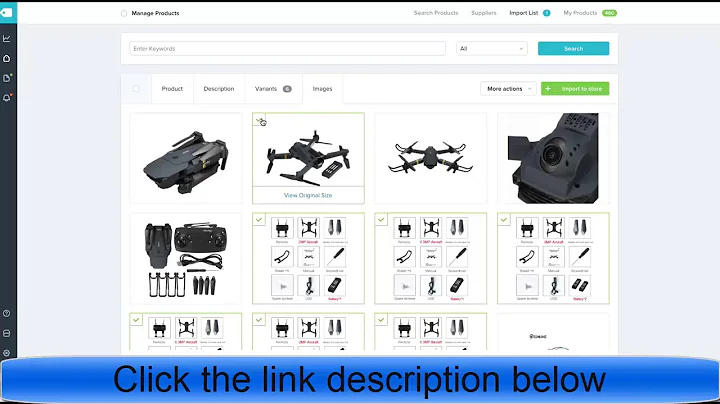The Truth About Shopify Dropshipping: Debunking Scam Myths
Table of Contents:
- Introduction
- The Truth About Shopify dropshipping
2.1. The Winning Product Trap
2.2. The Drop Branding Approach
- Overcoming Challenges in Dropshipping
3.1. Long Shipping Times
3.2. Poor Quality and Reliability
3.3. Scaling and Payment Processor Issues
3.4. Ad Fatigue and Copycats
- Building a Sustainable Dropshipping Business
4.1. Finding Private Agents or Suppliers
4.2. Utilizing 3PL Fulfillment Centers
4.3. Domestic Shipping as a Game Changer
- Skills Required for Dropshipping Success
5.1. The Importance of Marketing Creatives
5.2. Outsourcing Other Key Skills
- Debunking Myths about Dropshipping
6.1. Is Dropshipping a Scam?
6.2. The Reality of Guru Programs
- Conclusion
The Truth About Shopify Dropshipping
Dropshipping has gained popularity as a business model in recent years, and many people are drawn to its potential for quick and easy money-making. However, there are important truths and misconceptions that need to be addressed when it comes to dropshipping, particularly with regards to Shopify. In this article, we will uncover the reality behind Shopify dropshipping and explore the different approaches to succeed in this competitive industry.
Introduction
In the world of dropshipping, there is a common misconception that it is a gimmicky hack or a side hustle to make quick money online. However, the truth is that dropshipping is simply a fulfillment method for product-based businesses. Rather than holding inventory in a warehouse or garage, dropshippers rely on their manufacturers or suppliers to directly ship products to customers. This eliminates the need for holding costs and the hassles associated with inventory management.
While dropshipping offers a low-risk entry into the world of entrepreneurship, it is essential to understand the different approaches to be successful in this industry. In this article, we will uncover the truth about Shopify dropshipping and discuss various strategies to build a sustainable and profitable business.
The Truth About Shopify Dropshipping
Before diving into the details, it is crucial to understand that there are two main types of Shopify dropshipping. The first method involves rapidly searching for viral winning products, building a cheap-looking website, and relying on Facebook ads to generate sales. This method is commonly known as the "winning product trap." While it can be lucrative in the short term, this approach has its drawbacks.
One of the main issues with the winning product trap is the high level of competition in the dropshipping industry. As dropshipping gains mainstream popularity, more brands adopt this method, resulting in increased competition and a decline in profitability. Additionally, relying solely on winning viral products lacks longevity. These products often experience a hype phase, followed by a rapid decline in demand. For example, the fidget spinner craze quickly fizzled out after selling millions of units within a couple of months.
The second method, which is more challenging yet sustainable, is what I like to call the drop branding approach. Instead of solely relying on winning products, this approach focuses on validating offers, identifying hungry buyers, and positioning oneself as an authority and brand in a specific niche. This method involves overcoming common issues in dropshipping such as long shipping times, poor quality and reliability, scaling and payment processor issues, and ad fatigue.
Overcoming Challenges in Dropshipping
To succeed in dropshipping, it is crucial to address and overcome various challenges. Long shipping times often lead to dissatisfied customers, so reducing these times by utilizing domestic shipping and 3PL fulfillment centers can significantly improve the customer experience. Furthermore, ensuring product quality and reliability by establishing relationships with private agents or suppliers is essential. This allows for better insight into product quality and the ability to negotiate favorable profit margins.
Additionally, scaling a dropshipping business can present challenges with payment processors. However, by improving shipping times and providing tracking information promptly, payment holds can be released more quickly, allowing for increased liquidity to invest in business growth.
Building a Sustainable Dropshipping Business
Successfully building a sustainable dropshipping business requires a combination of skills and strategies. While it is possible to outsource certain areas such as web design and copywriting, the marketing creatives component is crucial to success. Creating compelling ad creatives and developing a strong marketing strategy sets successful dropshippers apart from the competition.
When it comes to marketing, it is essential to focus on the problem you solve rather than simply listing product features. By showcasing how your product addresses a specific need or desire, you can appeal to customers on a deeper level.
Debunking Myths about Dropshipping
There is often confusion surrounding dropshipping, with some questioning its legitimacy and skeptics claiming that gurus only use it to make money themselves. In reality, dropshipping is a legitimate fulfillment method that provides value to customers. It is not a scam or a fraudulent practice.
While some gurus in the industry offer courses and mentorship programs, it is important to approach these programs with caution. While legitimate education and guidance can be helpful, it is crucial to research and choose reputable sources.
Conclusion
Dropshipping, particularly via Shopify, offers a low-risk entry into the world of entrepreneurship. However, it is essential to understand the realities and challenges of the industry to build a sustainable and profitable business. By adopting a drop branding approach, overcoming common challenges, and honing marketing creatives skills, aspiring dropshippers can position themselves for success in this competitive market.
Highlights:
- Dropshipping is a fulfillment method for product-based businesses that eliminates the need for inventory management.
- There are two main types of Shopify dropshipping: the "winning product trap" and the drop branding approach.
- Overcoming challenges such as long shipping times and poor quality is crucial for building a sustainable dropshipping business.
- Marketing creatives, including compelling ad strategies and problem-solving approaches, are key to success in dropshipping.
- Dropshipping is a legitimate business model, but caution should be exercised when considering guru programs and courses.



















